The Most Common Houseplant Pests
And how to get rid of them.

Thrips are among the more common creepy crawlies that cause havoc on houseplants.by Tomasz Klejdysz/Shutterstock
Is your houseplant sad or struggling? There could be many reasons why. Is it getting too much sun, or maybe not enough? Are you underwatering or, more likely, overwatering it? Is the soil packed too densely? Does it need to be fed a fertilizer? Or, even worse, has it been taken over by pests?
Infestations happen, and they are more likely to happen when a plant is stressed or weakened. To prevent infestations, make a habit of checking your plants regularly, looking under leaves and in the soil for bugs and other critters. Prune away leaves that are yellowed, dried out or visibly damaged so there’s no detritus on which pests can feed. Whenever you bring home a new houseplant, quarantine it away from other plants. As we humans have learned, isolation will stop possible diseases or pests from spreading.
If you do have an infestation, the culprit is likely to be one of these common houseplant pests. The sooner you catch them, the easier it will be to get rid of them. If you find any little critters taking over your perfectly potted pothos or other prized plantings, immediately move it away from healthy ones while you address the problem. Here’s how to identify the pests—and more importantly, how to get rid of them.
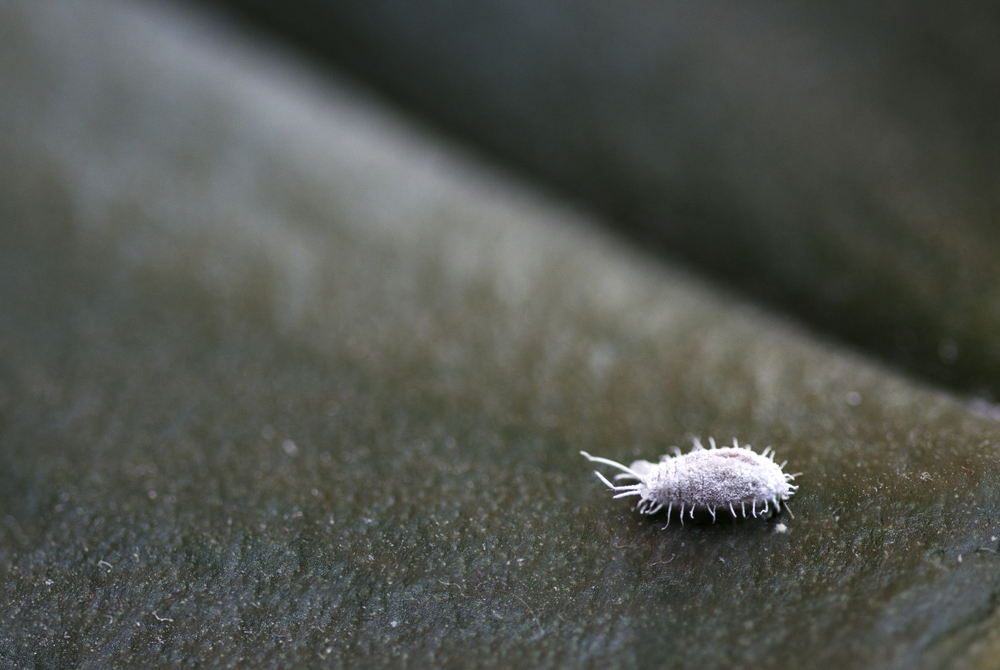
Mealybugs
How to identify: Easily confused for dust, mealybugs are a type of scale insect. These oval-shaped, soft-bodied insects look like little white pieces of dryer lint. They love to suck the life out of your plant, feeding on its juices. You’ll find them festering in small colonies on the undersides of leaves, around new growth and in tiny nooks between the leaves and stems.
How to get rid of them: Mealybugs are persistent and spread quickly, so they can be difficult to get under control. You can start by dipping a cotton swab in alcohol and dabbing each mealybug you see. Then treat the plant with neem oil, an effective fungicide and pesticide that isn’t toxic to humans and pets when used correctly. Dilute 1 teaspoon of neem oil and ½ teaspoon of dish soap with 1 quart of water. Shake it up in a spray bottle and apply it to the plant thoroughly, particularly the undersides of the leaves. Mealybug eggs are resilient, so if the infestation persists a week later, repeat this routine.
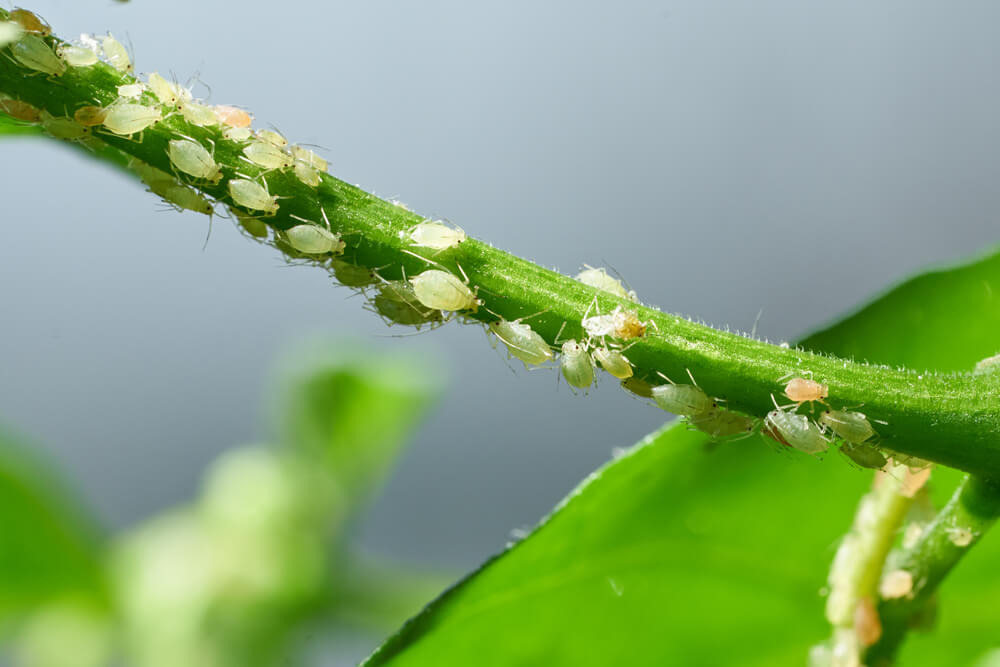
Aphids
How to identify: Small (less than ¼ inch) and soft-bodied, these pesky, pear-shaped insects have long legs and long antennae and can be white, brown, black, light green, orangish and even pink. Aphids prefer new growth and feed on soft stems, branches and buds, piercing the stems and leaves and sucking nutrient-rich sap from the plant. They feed in groups and leave behind yellowed leaves and deformed flowers. They also give birth to live young, meaning they can spread rapidly.
How to get rid of them: Spray aphids off of plants with a strong stream of water from a garden hose or shower head. Pick any remaining ones off and crush them with your fingers. You can also make a homemade spray by mixing 1 tablespoon of a pure liquid soap (such as Castile) with 1 liter of water, then spraying the mixture directly on the affected parts of the plant. Your pre-mixed neem oil spray (see above) is also your friend here.
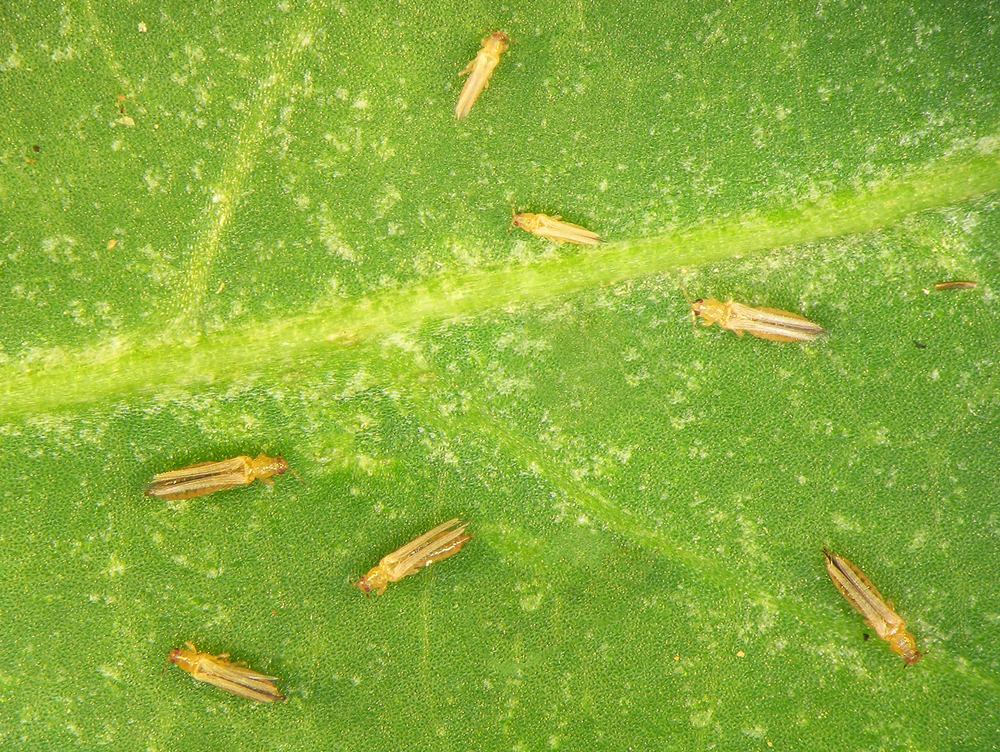
Thrips
How to identify: Also known as thunderflies, thrips are small, slender, dark-colored bugs that are common garden pests that can get inside and wreak havoc on your indoor plants. The first sign of a thrip infestation is faded or blotchy leaves. You’ll see them crawling—and perhaps flying—as they suck the sap out of leaves, stems, flowers and buds, usually starting on the undersides of the leaves. They also leave droplets of excrement behind, which will look like black, varnish-like specks.
How to get rid of them: Take the affected plant outside or into the shower and rinse off the leaves to quickly knock down their population. Soap kills thrips on contact, so the best route to getting rid of them is by spraying your plant with a pre-mixed organic insecticidal soap or with a diluted mixture of 1 teaspoon of mild liquid soap and 1 liter of water. Again, your trusted neem oil spray is good to use, too.
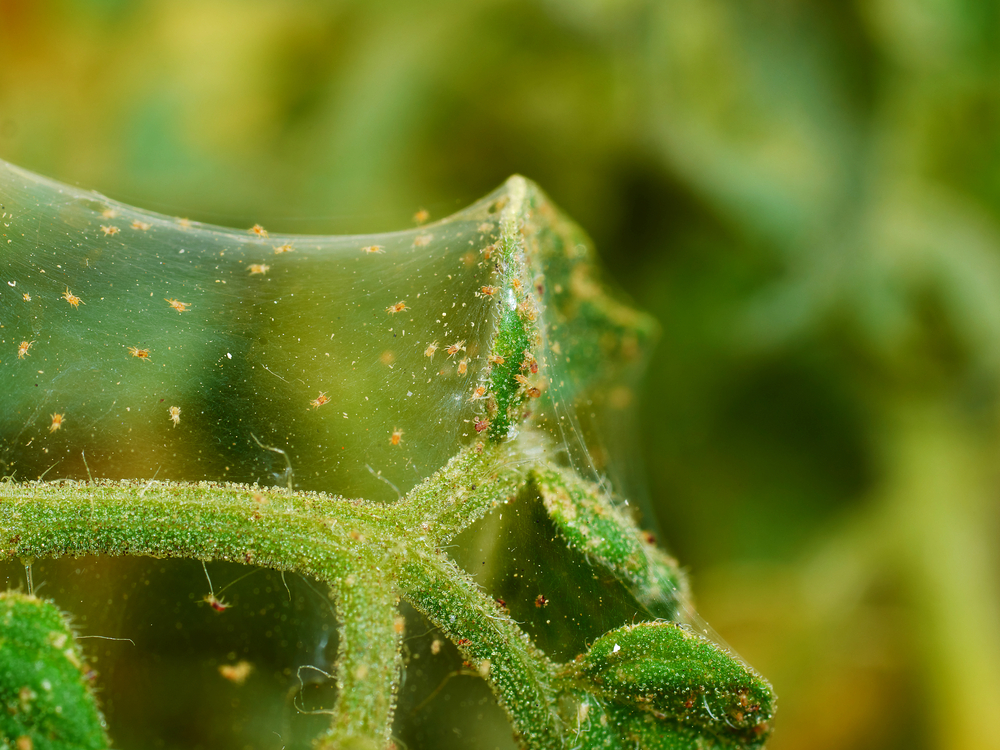
Spider mites
How to identify: Spider mites are the bane of any plant lover’s existence. They often go unnoticed because people think their tiny webs are normal spiderwebs. Only it isn’t a spider, most of the time, but a nasty little mite that is barely visible to the human eye. They usually start feeding on the underside of plant leaves, and they are most active in dry, hot conditions—such as on a plant positioned near a heating duct. The first sign of a spider mite infestation is plant damage such as light-color speckling on the upper surface of leaves.
How to get rid of them: Dislodge the spider mites and break up their webs with a strong stream of water from a hose or shower head. Plants can also be treated with an insecticidal soap or neem oil spray. It’s often necessary to spray once a week for several weeks to get a spider mite infestation under control.
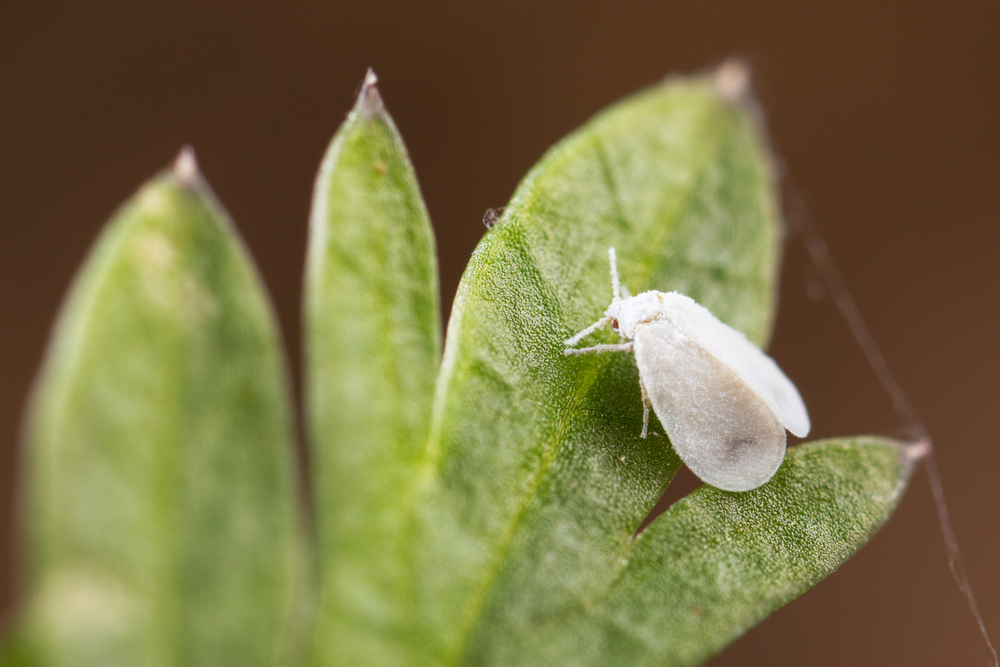
Whiteflies
How to identify: Whiteflies are not actually true flies and are more closely related to mealybugs and aphids. Powdery white in appearance (hence the name), they are very small, usually between 1/10 and 1/16 inches long, and look like little white moths. They suck juices from plants, causing leaves to yellow and fall off.
How to get rid of them: Whiteflies are attracted to the color yellow, so you can catch them using yellow sticky traps. If the problem persists, blast the leaves with short bursts of water, and spray that beloved neem oil mixture on the plant to kill all stages of the pest: eggs, larvae and adults.
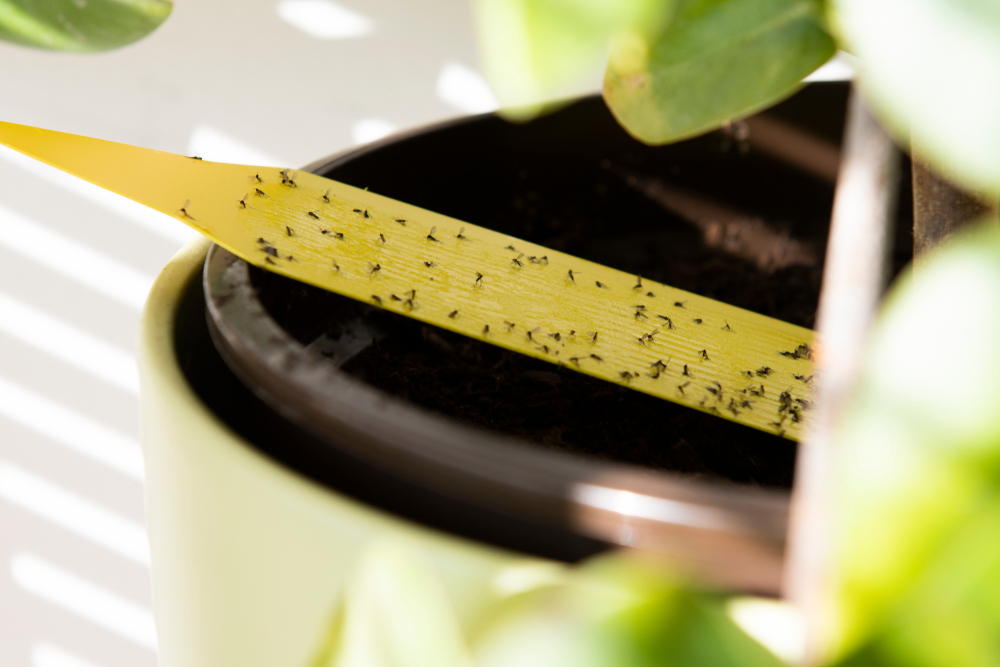
Fungus gnats
How to identify: Gnats are more annoying than they are pest-like and not too problematic for your houseplants. Usually the result of over-watering, these tiny flies breed in damp soil and feed on roots during their larval stage. Once hatched, you’ll see them flying out of your plant’s pot when you water it.
How to get rid of them: Allow your soil to dry out completely and stop overwatering it! You can also use a sticky fly or gnat trap to attract adult gnats. To treat the soil, dilute 3% hydrogen peroxide (1 part peroxide plus four parts water) and water the soil with the mixtures. You can also spray diluted neem oil on foliage to deter adult gnats.
Follow us
This work is licensed under a Creative Commons Attribution-NoDerivatives 4.0 International License.
Want to republish a Modern Farmer story?
We are happy for Modern Farmer stories to be shared, and encourage you to republish our articles for your audience. When doing so, we ask that you follow these guidelines:
Please credit us and our writers
For the author byline, please use “Author Name, Modern Farmer.” At the top of our stories, if on the web, please include this text and link: “This story was originally published by Modern Farmer.”
Please make sure to include a link back to either our home page or the article URL.
At the bottom of the story, please include the following text:
“Modern Farmer is a nonprofit initiative dedicated to raising awareness and catalyzing action at the intersection of food, agriculture, and society. Read more at <link>Modern Farmer</link>.”
Use our widget
We’d like to be able to track our stories, so we ask that if you republish our content, you do so using our widget (located on the left hand side of the article). The HTML code has a built-in tracker that tells us the data and domain where the story was published, as well as view counts.
Check the image requirements
It’s your responsibility to confirm you're licensed to republish images in our articles. Some images, such as those from commercial providers, don't allow their images to be republished without permission or payment. Copyright terms are generally listed in the image caption and attribution. You are welcome to omit our images or substitute with your own. Charts and interactive graphics follow the same rules.
Don’t change too much. Or, ask us first.
Articles must be republished in their entirety. It’s okay to change references to time (“today” to “yesterday”) or location (“Iowa City, IA” to “here”). But please keep everything else the same.
If you feel strongly that a more material edit needs to be made, get in touch with us at [email protected]. We’re happy to discuss it with the original author, but we must have prior approval for changes before publication.
Special cases
Extracts. You may run the first few lines or paragraphs of the article and then say: “Read the full article at Modern Farmer” with a link back to the original article.
Quotes. You may quote authors provided you include a link back to the article URL.
Translations. These require writer approval. To inquire about translation of a Modern Farmer article, contact us at [email protected]
Signed consent / copyright release forms. These are not required, provided you are following these guidelines.
Print. Articles can be republished in print under these same rules, with the exception that you do not need to include the links.
Tag us
When sharing the story on social media, please tag us using the following: - Twitter (@ModFarm) - Facebook (@ModernFarmerMedia) - Instagram (@modfarm)
Use our content respectfully
Modern Farmer is a nonprofit and as such we share our content for free and in good faith in order to reach new audiences. Respectfully,
No selling ads against our stories. It’s okay to put our stories on pages with ads.
Don’t republish our material wholesale, or automatically; you need to select stories to be republished individually.
You have no rights to sell, license, syndicate, or otherwise represent yourself as the authorized owner of our material to any third parties. This means that you cannot actively publish or submit our work for syndication to third party platforms or apps like Apple News or Google News. We understand that publishers cannot fully control when certain third parties automatically summarize or crawl content from publishers’ own sites.
Keep in touch
We want to hear from you if you love Modern Farmer content, have a collaboration idea, or anything else to share. As a nonprofit outlet, we work in service of our community and are always open to comments, feedback, and ideas. Contact us at [email protected].by Shelby Vittek, Modern Farmer
March 28, 2021
Modern Farmer Weekly
Solutions Hub
Innovations, ideas and inspiration. Actionable solutions for a resilient food system.
ExploreExplore other topics
Share With Us
We want to hear from Modern Farmer readers who have thoughtful commentary, actionable solutions, or helpful ideas to share.
SubmitNecessary cookies are absolutely essential for the website to function properly. This category only includes cookies that ensures basic functionalities and security features of the website. These cookies do not store any personal information.
Any cookies that may not be particularly necessary for the website to function and are used specifically to collect user personal data via analytics, ads, other embedded contents are termed as non-necessary cookies.
So disappointed that you did not deal with the nasty brown scale which is the bane of my greenhouse. I have been using the firm hose, alcohol swab, and then neem oil spray method which keeps them decreased but never gone. I have to stay so vigilant. I hesitate giving my plants to friends, I would hate to set them up for an infestation!
Please recommend some chemical so I can spray my whole garden because i see some Mealybugs in my plants. I have fogger machine please tell me.
I lost my indoor plants to some insects that looked like Aphids but were only on and in the dirt of the plant pot not on any parts of the plant that was out of the soil. Could they still be a kind of aphid? The one time I was managing to have plants grow and those ugly little pale brownish colony needed to show up and kill them all. They had COVERED all the soil and they were so small that from afar I could never tell that the layer on the top wasn’t soil but a massive population… Read more »